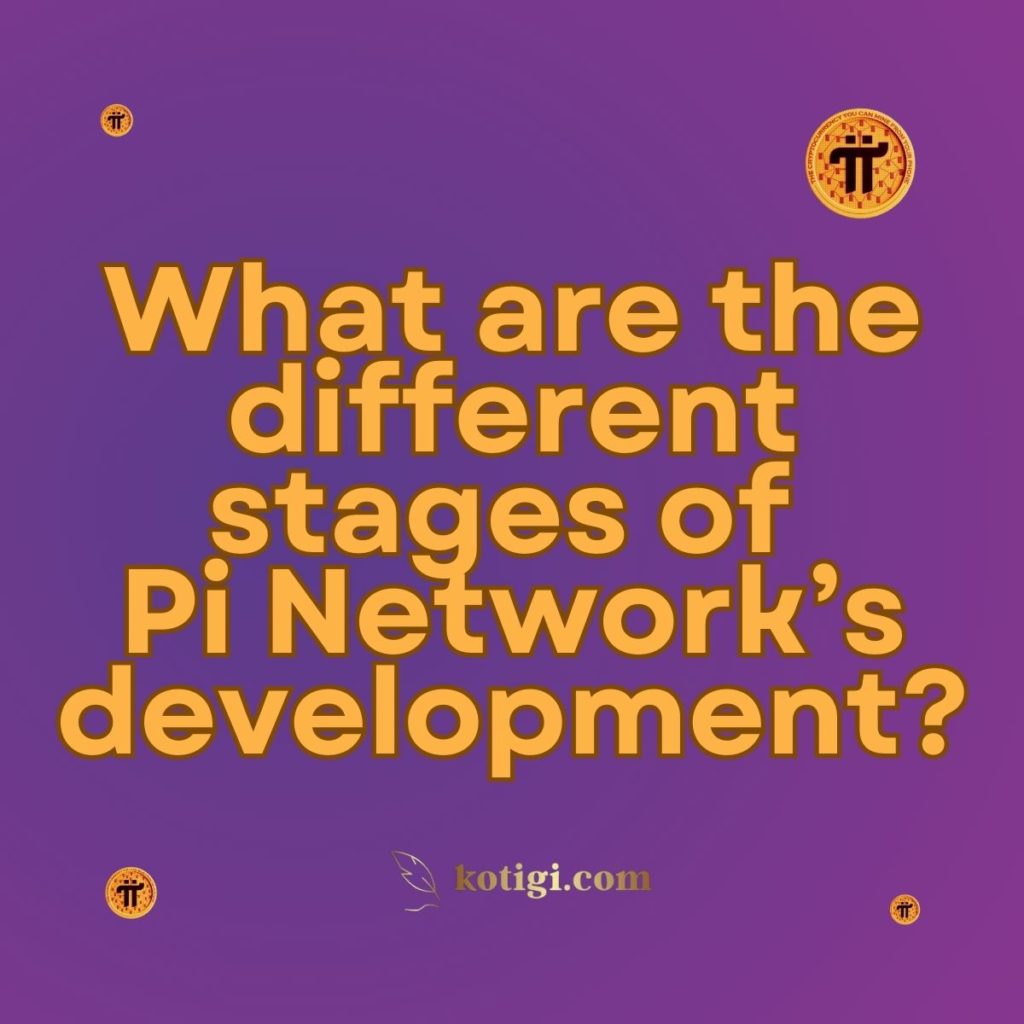
What are the different stages of Pi Network’s development?
Pi Network’s development journey consists of multiple phases, each designed to enhance its technological capabilities and global reach. From its inception to its goal of full decentralization, Pi is evolving to create a more accessible, decentralized, and scalable cryptocurrency ecosystem.
Introduction
The Pi Network has embarked on a dynamic journey since its inception, attracting millions of users worldwide with its promise of a decentralized, user-friendly cryptocurrency. As the project progresses, it is critical to understand the different stages of its development, each of which plays a vital role in shaping the future of Pi. From its early conceptual stages to its present focus on expanding its ecosystem and achieving full decentralization, Pi Network has established itself as a growing force in the cryptocurrency world. Each development stage reveals its commitment to scalability, user empowerment, and global adoption.
1. Conceptualization Stage
The first stage of Pi Network’s development revolved around formulating the vision and core principles of the project. At this stage, the team behind Pi Network set out to create a cryptocurrency that would break the barriers associated with traditional blockchain technology, primarily the high entry costs for mining and energy consumption.
1.1 Vision for Decentralization
From the outset, Pi Network was conceived with a decentralized architecture in mind. The founders recognized that one of the greatest challenges in the cryptocurrency world was creating a system that could be both decentralized and accessible. The network’s vision was to allow everyday people, not just large mining operations, to participate in securing the network, thus ensuring a truly decentralized ecosystem.
1.2 Mobile Mining Innovation
Pi Network introduced a revolutionary concept of mobile mining, making it possible for users to mine Pi coins on their smartphones without consuming excessive battery power or computational resources. This innovation addressed a significant hurdle in traditional mining practices, where high energy and hardware costs limited participation. Pi’s mobile mining allowed millions of people worldwide to join the cryptocurrency revolution.
1.3 Early Community Building
To solidify the foundation of the Pi Network, the team prioritized building a strong community. Early adopters were invited to join via an invitation system, which not only helped grow the network but also fostered a sense of exclusivity and belonging. The network’s referral-based growth model incentivized users to introduce new participants, laying the groundwork for the expansion of the Pi ecosystem.
2. Beta Phase
The second stage in Pi Network’s development was the beta phase, a period marked by significant technical development, community feedback, and the scaling of the user base. During this phase, the project shifted from mere ideas to practical implementation, with users mining Pi coins in a test environment.
2.1 Testnet Launch
Pi Network’s beta phase was marked by the introduction of the Testnet, a blockchain simulation where users could begin mining Pi without any financial risk. This test environment allowed the developers to observe the network’s performance under various conditions, such as user load and transaction volume.
2.2 Community Feedback Integration
During this phase, feedback from the growing Pi community was critical. The Pi Network development team actively engaged with users, addressing their concerns and integrating their suggestions into the platform. This collaborative approach helped refine the network’s features, improve user experience, and create a more robust ecosystem.
2.3 Security and Scalability Testing
The beta phase also focused on testing the security and scalability of the network. Pi Network’s engineers conducted multiple stress tests to ensure the platform could handle large volumes of transactions while maintaining its security protocols. As the user base rapidly expanded, scalability became a major concern, and this phase was crucial in identifying and solving potential bottlenecks.
2.4 Growth of the User Base
The Pi Network saw exponential growth during its beta phase. By leveraging its referral model, Pi attracted millions of users from around the world, making it one of the fastest-growing networks in the cryptocurrency space. This rapid expansion helped solidify its position and foster community engagement.
3. Mainnet Launch (Ongoing)
The transition to the mainnet represents a critical milestone in Pi Network’s development. In this stage, Pi Network moves from being a test project to a fully functioning blockchain with real-world applications.
3.1 KYC and Migration
As Pi prepares for its mainnet launch, a significant focus is on verifying users’ identities through a KYC (Know Your Customer) process. This step ensures that real, verified users are participating in the network, which is crucial for the integrity and security of the blockchain. Only users who pass KYC will have their Pi tokens migrated from the testnet to the mainnet.
3.2 Decentralized Ecosystem
The Pi Network’s mainnet will enable a fully decentralized ecosystem where users can engage in various activities, such as trading Pi, utilizing decentralized applications (dApps), and participating in governance decisions. By decentralizing control and operation, the Pi mainnet will empower its global community to take part in a peer-to-peer economy.
3.3 Token Utility Expansion
The mainnet stage also focuses on expanding the utility of Pi tokens beyond just mining. Pi tokens will be usable for transactions, payments, and a range of other decentralized finance (DeFi) applications within the Pi ecosystem. This step is critical in moving Pi from a speculative asset to a functional cryptocurrency that can be used in everyday commerce.
4. Ecosystem Development Stage
As Pi Network progresses, its next phase is about fostering a thriving ecosystem that can support a variety of use cases, including business applications, merchant integration, and decentralized finance solutions.
4.1 Developer Onboarding
To support the growth of Pi’s ecosystem, the network actively engages developers by providing them with the necessary tools to build dApps on the Pi blockchain. By incentivizing developers with grants and rewards, Pi encourages innovation that will help the network achieve widespread utility.
4.2 Merchant Integration
A key component of Pi Network’s ecosystem development is its focus on merchant integration. This stage involves onboarding businesses that are willing to accept Pi tokens as a form of payment. By partnering with merchants globally, Pi aims to create a functional economy where users can exchange goods and services using Pi tokens.
4.3 Pi Network Marketplace
One of the flagship initiatives of this stage is the creation of a Pi Network marketplace, where users can trade goods and services using Pi tokens. This marketplace will be central to driving adoption and providing real-world use cases for Pi, transforming it into a practical currency rather than just a mined asset.
5. Expansion and Global Adoption
Pi Network aims to expand its reach and become a mainstream cryptocurrency. This stage focuses on establishing partnerships, developing local strategies, and collaborating with global entities to facilitate worldwide adoption.
5.1 International Partnerships
Strategic partnerships with global companies and organizations will play a crucial role in Pi’s global expansion. These collaborations will enhance the network’s credibility and enable its services to be adopted in diverse regions, accelerating its international presence.
5.2 Regional Adoption Strategies
Pi Network recognizes that different regions have varying levels of cryptocurrency adoption. As such, the network tailors its growth strategies to target regions where blockchain technology is gaining momentum, creating customized approaches to drive adoption in those areas.
5.3 Collaborations with Governments
As Pi Network continues to expand, its relationship with government entities becomes increasingly important. Ensuring compliance with regional regulations and working alongside policymakers will help the network establish itself as a legitimate and secure cryptocurrency.
6. Regulatory and Compliance Stage
Ensuring Pi Network’s compliance with global regulatory standards is crucial for its long-term success and mainstream acceptance. This stage focuses on addressing legal challenges and securing necessary approvals.
6.1 Regulatory Approvals
Pi Network is committed to obtaining regulatory approvals in the various jurisdictions it operates. This step is essential for ensuring that Pi can legally operate as a cryptocurrency while maintaining transparency and accountability.
6.2 Data Privacy and Security
Given the global nature of Pi Network, compliance with data privacy regulations like GDPR is a priority. The network takes user privacy seriously and implements robust security measures to safeguard user data and transactions.
6.3 Cross-Border Regulations
As Pi expands its global user base, navigating cross-border regulations will be increasingly important. Pi Network must ensure that its operations comply with the laws of different countries, particularly those with strict cryptocurrency regulations.
7. Full Decentralization Stage
The final stage in Pi Network’s development is achieving full decentralization, which ensures that no central authority controls the network and all decisions are made by the community.
7.1 Node Participation
One of the key aspects of decentralization is the participation of individual users in running nodes. Pi Network is encouraging its user base to set up nodes, which will help secure the network and facilitate decentralized decision-making.
7.2 Governance by the Community
Pi Network aims to introduce decentralized governance mechanisms where the community can vote on key issues, such as protocol changes and upgrades. This will allow Pi to be truly governed by its users, fostering trust and transparency.
7.3 Self-Sustaining Ecosystem
The ultimate goal of full decentralization is to create a self-sustaining ecosystem where Pi tokens can be used in real-world applications without the need for centralized control. By achieving this, Pi Network will become a community-driven platform with widespread utility.
Conclusion
Pi Network’s development journey is a multi-phase process that aims to transform it into a fully decentralized, scalable, and globally accepted cryptocurrency. Each stage, from conceptualization to mainnet launch and beyond, is essential in shaping Pi’s future. As the network grows, it is increasingly focusing on regulatory compliance, technological innovation, and global expansion, all of which are crucial for Pi’s long-term sustainability.
Key Takeaways
- Pi Network has progressed through various stages, including conceptualization, beta testing, and the mainnet launch.
- The network’s mobile mining innovation makes it accessible to millions of users worldwide.
- The mainnet transition focuses on KYC, expanding token utility, and building a decentralized ecosystem.
- Pi Network is developing an ecosystem that supports decentralized applications, merchant integration, and marketplaces.
- Achieving full decentralization will empower the Pi community to govern and sustain the network independently.
- Global partnerships and regulatory compliance are key to ensuring Pi’s legitimacy and expanding its reach.





